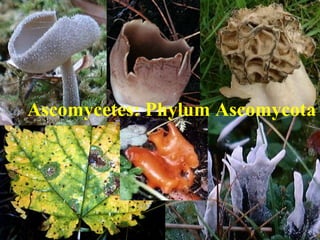Fungi-ascomycete
•Download as PPT, PDF•
28 likes•31,000 views
Ascomycetes are a large phylum of fungi characterized by producing sexual spores called ascospores within a sac-like structure called an ascus. Common types of ascomycetes include yeasts, powdery mildews, and cup fungi. Ascomycetes can cause food spoilage and plant diseases but also include many edible mushrooms and fungi used to produce antibiotics. The lifecycle of ascomycetes involves both asexual reproduction via conidia and sexual reproduction involving the formation of ascospores within asci.
Report
Share
Report
Share

Recommended
More Related Content
What's hot
What's hot (20)
Similar to Fungi-ascomycete
Similar to Fungi-ascomycete (20)
More from Merlyn Denesia
More from Merlyn Denesia (20)
Recently uploaded
Recently uploaded (20)
TEST BANK For Radiologic Science for Technologists, 12th Edition by Stewart C...

TEST BANK For Radiologic Science for Technologists, 12th Edition by Stewart C...
Pulmonary drug delivery system M.pharm -2nd sem P'ceutics

Pulmonary drug delivery system M.pharm -2nd sem P'ceutics
PossibleEoarcheanRecordsoftheGeomagneticFieldPreservedintheIsuaSupracrustalBe...

PossibleEoarcheanRecordsoftheGeomagneticFieldPreservedintheIsuaSupracrustalBe...
Physiochemical properties of nanomaterials and its nanotoxicity.pptx

Physiochemical properties of nanomaterials and its nanotoxicity.pptx
Formation of low mass protostars and their circumstellar disks

Formation of low mass protostars and their circumstellar disks
Forensic Biology & Its biological significance.pdf

Forensic Biology & Its biological significance.pdf
Labelling Requirements and Label Claims for Dietary Supplements and Recommend...

Labelling Requirements and Label Claims for Dietary Supplements and Recommend...
Recombinant DNA technology (Immunological screening)

Recombinant DNA technology (Immunological screening)
Pests of mustard_Identification_Management_Dr.UPR.pdf

Pests of mustard_Identification_Management_Dr.UPR.pdf
Unlocking the Potential: Deep dive into ocean of Ceramic Magnets.pptx

Unlocking the Potential: Deep dive into ocean of Ceramic Magnets.pptx
Biopesticide (2).pptx .This slides helps to know the different types of biop...

Biopesticide (2).pptx .This slides helps to know the different types of biop...
Fungi-ascomycete
- 2. Ascomycetes • Group of fungi characterized by their production of sexual spores in a sac-like structure called an ascus.
- 3. “Cup fungus”
- 4. Types of Ascomycete • yeast • powdery mildew • cup fungi – many of these produce spores suited for airborne dispersion.
- 5. The Ascomycota • Non motile •Form ascospores Internally in Asci •Most are blue-green, red and brown molds that cause food spoilage •Penicillin
- 6. Ascomycetes Eyelash cup, Scutellinia scutellata
- 7. Ascomycetes can cause plant disease • Brown rot of stone fruits (Monilinia fructicola) •chestnut blight (Cryphonectria parasitica)
- 8. Dutch elm disease ( Ophiostoma ulmi)
- 9. Beneficial Ascomycete • Many Yeast are also ascomycetes •Edible Morels and truffles
- 10. Edible black truffle, Tuber melanosporum spore-bearing structure is produced below ground mainly on oaks and hazelnuts
- 12. Ascomycetes growth • Most have either unicellular or filamentous growth forms • Hyphae have perforated septa • Hyphal cells of Vegetative mycelim may be either uninucleated or multinucleated • Some are homothallic others heterothallic
- 13. Life cycle of an Ascomycete • Most species undergo asexual reproduction by the formation of multinucleated conidia • Conidia formed from the conidiogenous cells • Conidiogeneous cells are borne at the tips of modified hyphae called conidiophores “conidia bearers”
- 14. Conidia- the characteristic asexual spores of ascomycetes shows the stages in the formation of conidia which infects the velvetbean caterpillar
- 15. TEM of Various stages of developments of conidida
- 16. Ascomycetes spore development vs. Zygomycetes spore development • Unlike zygomycetes which produce spores internally within a sporangium, ascomycetes produce their asexual spores externally as conidia.
- 17. Sexual reproduction in Ascomycetes • Always involves the formation of an ascus (pl. asci)- saclike structure within which a haploid ascospores are formed following meiosis. • Because the ascus resembles as sac, commonly referred to as “sac fungi” • Both the asci and ascospores are unique structures that distinguish the ascomycetes from all other fungi • Ascus formation usually occurs within a complex structure composed of tightly interwoven hyphae- the ascoma (pl. ascomata) or ascocarp.
- 18. Maturing ascospores in Asci of Ascodesmis nigricans
- 19. Enclosed asci and ascospores of Ascoma called a cleistrothecium
- 20. An ascoma of Coniochaeta showing the enclosed asci and ascospores Perithecium- fruiting body contains ascospores
- 21. Xylaria fungus “Dead mans fingers” Perithecium with ascospores Finger Xsec
- 22. Hymenial layer • Asci usually develop on an inner surface of the asoma, a layer called the hymenium or hymenial layer
- 23. Hymenium of an ascomycete showing asci with ascospores section thru the hymenial layer of Morela
- 24. Life cycle of Ascomycete • The mycelium grows out from a germinating ascospore • Mycelium begins to reproduce asexually by forming conidia • Many conidia are produced • Conidia are responsible for propagating and disseminating the fungus
- 26. Sexual Reproduction • Occurs on the same mycelium that produces conidia • The formation of multinucleate gametangia called antheridia (male) and ascogonia (female) precedes sexual reproduction • Male nuclei pass into the ascogonium via the trichogyne which is an outgrowth of the ascogonium • Genetically different nuclei pair but do not fuse • Ascogenous hyphae now begin to grow • Compatible pairs of nuclei migrate and cell division occurs and creates dikaryotic cells- two compatible haploid nuclei
- 28. • Crozier- the apical cell of the ascogenous hypha which allows the paired nuclei to divide simultaneously • Compatible pair of nuclei fuse (karyogamy) to form a zygote • Zygote undergoes meiosis producing ascus with 8 nuclei • Haploid nuclei cut off to form ascospores • Ascus as it matures becomes turgid, and finally burst to release its ascospores
